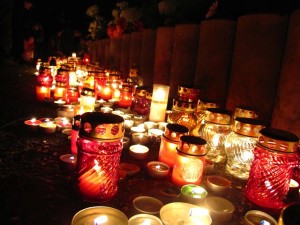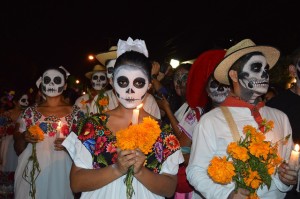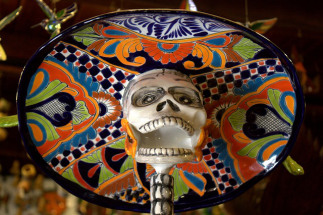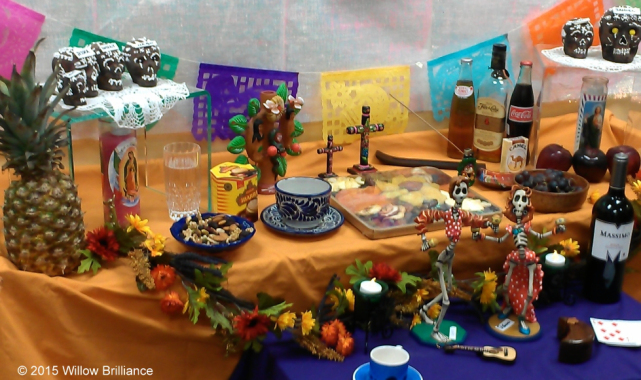
Happy Halloween! Lately, I’ve noticed a lot of Mexican skeletons and sugar skulls appearing alongside traditional Halloween decorations. These fun, whimsical figures are popping up everywhere, so I wanted to write more about them and how they can help connect us to the celebration of life, death and our loved ones.
In Mexican and Latin communities throughout the world, “Dia de los Muertos” (Day of the Dead) is observed on November 1st and 2nd in festivities to honour, commune with, pray for, and celebrate deceased loved ones as they visit the physical world in spirit on these special days. Related to the Catholic holidays of All Souls Day and All Saints Day, these celebrations have been tied to societies in pre-Hispanic and ancient Mexico as well.

This festival time is planned throughout the year and is much anticipated with families beginning preparations and making special foods and decorations well in advance. On October 30th or 31st preparations begin with home altars that are decorated with special brightly coloured artwork, special objects, toys, candles and foods called “ofrendas” (offerings) which are designed to delight and attract visiting spirits.
In some communities, actual grave sites are cleaned and painted and festooned with beautiful arches of flowers and thousands of candles as well as all the offerings. This is an amazing site to behold on festival nights with bands of music and families streaming in to celebrate.

One such treat is the sweet, egg bread called “Pan de Muerto” (bread of the dead) which is made into special shapes like people, animals, crosses, and other shapes. The breads may be plain or covered with special seeds.
Children spirits have special mini-Pan de Muerto and tiny plates and cups. A loved one’s favourite meal (usually Tamales or something elaborate to make or usually reserved for special occasions) is also on display along with traditional liquors and beverages such as mescal, tequila, and atole, an ancient thick corn beverage. Soda pop and beers are often displayed as well as any special treats or candies that a loved one especially liked.
Traditional candies are pumpkin candies and chocolates but Pop-Rocks, chewing gum, and modern candies are sometimes set out too (Sometimes you might even see chewing tobacco or cigarettes!) The most famous treat, of course, are the elaborately decorated and colourful sugar skulls called “calaveras de azúcar” that come in many shapes and sizes – often bearing the name of a loved one.
They’re made in a similar way as sugar-Easter eggs that most people are familiar with. The spirits are said to consume the “essence” of the foods so loved ones still on Earth may eat them or give them out later. Objects such as games or toys are placed for children and for adults, special mementos and photographs are displayed.
Music is played and special poems (often humorous ) about the deceased person are read and beautiful works of art are often created.
One influential artist named José Guadalupe Posada created the modern iconography closely associated with the festivities with the etching he created shortly before his death in 1913, “La Calavera Catrina” (The Elegant Skull) featuring a skeleton wearing a floral hat.

While the Day of the Dead may look like “Mexican Halloween” to some, with skulls and candles and candy, the holiday isn’t supposed to be just silly fun nor is it intended to be spooky.
Death is presented in the celebration as a certainty of life. In our American/Western culture, death is seen as something to avoid and the topic of our impending mortality is avoided at all costs, but in the Day of the Dead, death is embraced.
Prayers are read and told and loved ones swap stories and share funny or touching anecdotes about the loved ones who have passed on so that future generations and all members of a family can know more about who the loved ones were in life and to celebrate the gift of life.
In this way death is looked at as a part of natural life and a sense of continuity and bonding comes from sharing stories about the past. This story telling and connecting to loved ones in ritual is not unique just to Mexico – many countries the world over celebrate the deceased and cultures in Africa and Asia have similar celebrations to the Day of the Dead.
As you decorate your home, make sugar skulls, or get the little ones dressed up as monsters or princesses, remember the traditions of Halloween and Day of the Dead are those which symbolize something that is not evil, scary, or occult but rather the basic and fundamental part of life; the love and connection to our family expressed in the joyous days of our lives, and in the remembrance and celebration of all of life’s cycles of birth and death.
© 2015 Willow Brilliance in Sight/Psychic Scoop
Check out my website and BLOG for more goodies!
Want to get a personal reading about relationships, dating or personal growth? Contact me:
email me or chat with me to schedule an appointment for a 10, 15, 30, or 60 minute session.
I do readings via my chat messenger that anyone can use. Please let me know your time zone and the times most convenient for you.
You can also read more of my articles right here on the Psychic Scoop website.
- Meditation for People Who Think They Can’t - July 8, 2021
- Spotlight Reader of the Week – Willow - June 9, 2021
- 10 Huge Red Flags to Avoid in Dating - March 21, 2018


